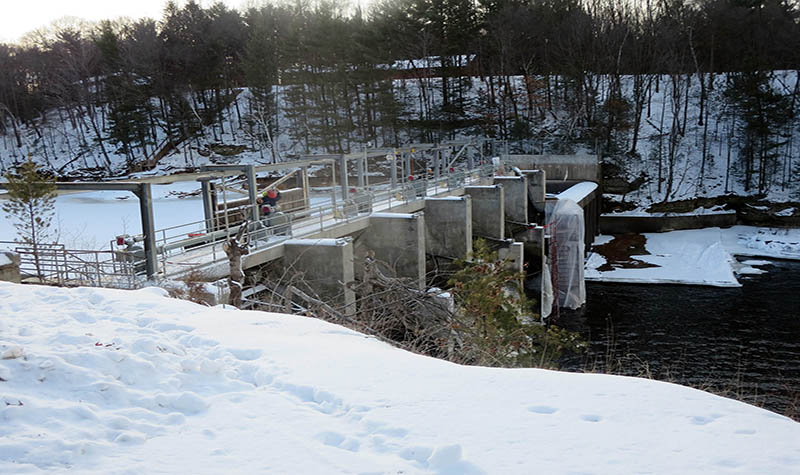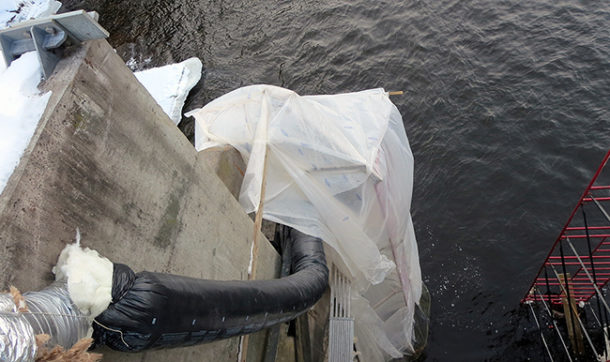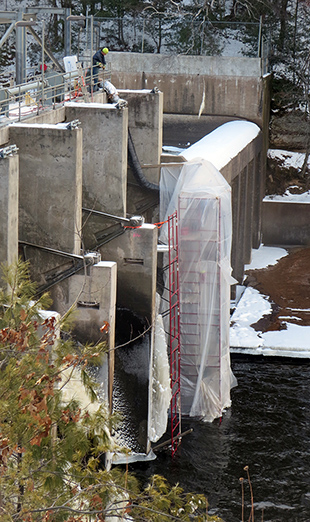How to Cure Concrete in Cold Conditions
 By Pete Haug, PE, and Todd Rudolph, PE
By Pete Haug, PE, and Todd Rudolph, PE
In any process where water is involved, crossing the freezing mark can be a deal breaker. That is the case for curing concrete, which needs to happen above freezing. Failure to adhere to this rule will result in curing that takes significantly longer – and possibly concrete that prematurely fails. For those in cold climates, it’s not always possible to schedule construction for the warmer months. The job can be accomplished in sub-freezing conditions, but not without taking a significant number of steps to keep the concrete above freezing during mixing and curing.

About the Expert:
Pete Haug, PE,, is a water resources engineer in our Eau Claire, WI, office and a certified instructor for NHI courses in Highway Hydraulics, Culvert Design, and Urban Hydrology. His primary focus is on dam inspection, hydraulic structure design, and spillway construction observation. His peer-reviewed papers include spillway discharge uncertainty, dam removal, spillway performance, and other hydraulic topics.

About the Expert:
Todd Rudolph, PE, joined Ayres in 1997. He performs a variety of engineering tasks, including hydraulic and hydrologic computations; design and inspection of hydraulic structures, such as gate design and inspection; and related structural design. He is Ayres’ lead structural engineer for the design of hinged floating bulkheads, which have been used nationwide for dewatering hydro project spillways.
The American Concrete Institute (ACI) continues to refine its advice on cold-weather pours, and a recent webinar presented by Erik Holck, a senior design engineer for Denver Water, addressed the reasons it’s important to protect curing concrete from freezing and how to provide and verify that protection.
Why Freezing And Curing Don’t Mix
At 25 to 27 degrees Fahrenheit, the freezing of pore water in curing concrete will halt hydration – and the curing process. Hydration is the chemical reaction in which the key compounds in cement form chemical bonds with water molecules and become hydrates or hydration products. Below 27 degrees, the formation of ice within curing concrete can damage concrete’s long-term integrity through cracking.

The ACI definition of cold weather – during which protective measures should be taken – has been simplified to include any actual or predicted drop in air temperature below 40 degrees Fahrenheit during a cold weather concrete protection period – the time during which curing concrete is recommended to be protected during cold weather. That period typically ranges from 1 to 6 days, with the shortest period applying to concrete that includes accelerated-set chemicals, is not under load during construction, and is not exposed to cold in service (after project completion). The longest curing period is required for concrete with no accelerants that is under load during construction and is exposed to cold in service.
What Temperature Should Be Maintained?
At the batch plant, concrete should be kept at 45 to 70 degrees, with the higher end of that range required for thinner concrete pours and colder outside air conditions. Lower temperatures in that range are acceptable at the plant if the air temperature is less severe and if the pour will be thicker. Upon pouring and throughout curing, the concrete must be kept at 40 degrees if more than 72 inches thick, 45 degrees if 36 to 72 inches thick, 50 degrees if 12 to 36 inches thick, or 55 degrees if less than 12 inches.
Here are a few more temperature tips that should guide any cold-weather concrete work:
- The surface, edges, and corners of the poured concrete are the most susceptible to cold and the most critical to protect.
- Rebar of No. 18 and smaller can be less than 32 degrees upon installation. So can formwork and steel I-beam and other embedments smaller than 4 inches square.
- However, surfaces in contact with the fresh concrete must be free of ice, snow, and frost, and concrete must not be placed on frozen subgrade. Hydronic (water or steam) heating tubes can be placed directly on the subgrade or on top of insulating blankets placed on the subgrade to thaw the subgrade before the pour.
How Do You Protect Concrete From Severe Temperatures?
Here are the best protection methods to insulate curing concrete from cold ambient air:
- Because concrete throws off heat during the chemical reactions of curing, insulated blankets and insulated formwork can be sufficient to maintain proper curing temperatures. They must be secured so that wind cannot blow them off. It is also important not to trigger thermal stress through overheating resulting from overinsulation.
- Strong, weather-proof, heated enclosures protect concrete within buildings, but curing membrane or additional water may be needed to prevent the surface from drying due to the use of heaters.
Monitoring Temperature Is Challenging

One of the trickier feats of cold weather concrete curing is the need to monitor the concrete temperature throughout curing to verify compliance with the 40- to 55-degree minimum concrete temperature. Maturity sensors can be used to measure the concrete’s internal temperature, and infrared thermometers can be used to measure the concrete’s surface temperature.
In-place strength – not number of curing days – must govern the ultimate period of protection for curing concrete. The trouble is that both lab cylinders and field cylinders poured at the same time as the main pour are unreliable in determining the strength of the concrete pour because they are difficult to keep at the same temperature as the main pour, and the cylinders also may be much more slender than the pour, causing them to cure at a faster pace. Maturity monitoring data calibrated with cylinder data can be used to verify in-place strength.
After the curing period is done, it is important not to shock the concrete with sudden exposure to much colder temperatures. The ACI-recommended maximum 24-hour temperature drop after removal of protection ranges from a 20-degree swing for concrete thicker than 72 inches to a 50-degree drop for concrete less than 12 inches thick.
The Cost of Winter Concrete Construction
Winter concrete construction is costly, partly because the concrete mix costs more, but mostly because worker productivity is lower because of all the work involved in heating and insulating during curing, setting up extra work site lighting, and compensating for low air humidity.
The dam spillway project pictured at the top of this post, for example, cost about $750,000 more for winter construction than it would have during summer. Part of that premium is attributable to the exceptionally cold conditions that winter, when temperatures went as low as 23 below and dipped into negative range during 20 days in January 2014. Partially mitigating the intrinsic costs of winter construction is the fact that contractors are motivated to “eat” some of the heating and enclosure costs just to keep their employees working during months when they otherwise would be seasonally laid off.
Have a Cold Weather Protection Plan
ACI deems communication a critical ingredient in a successful cold-weather concrete project, and it recommends engineers make sure the contractor provides a cold weather protection plan. This plan gives the engineer a chance to judge the contractor’s relative experience level, and it provides all parties an opportunity to get on the same page and for the engineer to share advice with the contractor to make sure all protection and monitoring equipment is lined up before the pour. The plan should include:
- Subgrade preparation and protection
- Temperature monitoring method
- Strength monitoring method
- Identification of protection methods such as enclosures, insulated formwork and blankets, hydronic heaters, and combustion heaters
- Mix design alterations
ACI recommends these planning tips to head off problems:
- Placing the concrete at as low a slump as possible to minimize bleed water and delays, as water may stand and freeze instead of evaporating.
- Avoiding starting the finishing process prematurely, which is tempting when contractors are working in abbreviated daylight conditions. Scaling can result from finishing while bleed water is still coming out of the concrete.
- Avoiding the use of excessive heat. For example, heaters inside enclosures can overheat the areas nearest to them.
Pete Haug, PE, a water resources engineer, has 20 years of experience in hydraulic engineering design and testing, with an emphasis on spillways. As engineer of record for multiple dam spillway, sluice gate, and river channel design and construction projects, he has completed multiple small dam repair designs, including projects requiring winter concrete construction in cold climates. Todd Rudolph, PE, a water resources engineer, designs and inspects hydraulic structures such as gates, completes hydraulic and hydrologic computations, and provides construction inspection support, including on projects requiring cold-weather concrete work.
Comments
Very useful information. Need more news like this in upcoming days.
Interesting
Thanks a lot for this valuable information.
Really useful information!

Post a comment: